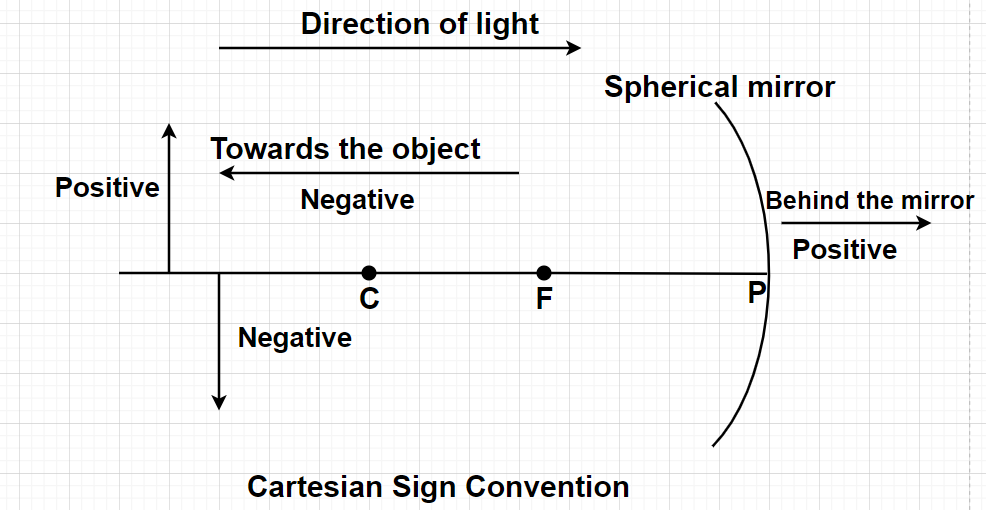
What is the Cartesian sign convention used for spherical mirrors?


Answer
597.9k+ views
- Hint- Here, we will be drawing the sign diagram which will represent the sign according to the object’s position. Based on this sign diagram all the signs of the important parameters like radius of curvature, focal length, etc are determined.
Complete step-by-step solution -
Cartesian sign convention in case of concave mirror:
$1.$ Since, the object is always placed in front of the mirror hence object distance is taken as negative.
$2.$ Since, the centre of curvature C and focus F lie in front of the concave mirror, so radius of curvature and focal length are taken as negative in the case of concave mirror.
$3.$ When an image is formed in front of the mirror, the distance of image is taken as negative and when image is formed behind the mirror, the distance of image is taken as positive.
$4.$ Height of image is taken as positive in the case of erect image and taken as negative in the case of inverted image.
Cartesian sign convention in case of convex mirror:
$1.$ Since, the object is always placed in front of the mirror hence object distance is taken as negative.
$2.$ Since, the centre of curvature C and focus F lies behind the convex mirror, so radius of curvature and focal length are taken as positive in the case of convex mirror.
$3.$ In the case of a convex mirror, the image is always formed behind the mirror, thus the distance of image is taken as positive.
$4.$ In the case of a convex mirror, always an erect image is formed, thus the height of the image is taken as positive always.
Note- The focal point is defined as the point at which incoming light rays that are parallel to the principal axis would meet after reflection and the focal length is the perpendicular distance from the centre of the mirror to the focal point. The radius of curvature is defined as the radius of the sphere that would be produced if the mirror was made into a full sphere.
Complete step-by-step solution -
Cartesian sign convention in case of concave mirror:
$1.$ Since, the object is always placed in front of the mirror hence object distance is taken as negative.
$2.$ Since, the centre of curvature C and focus F lie in front of the concave mirror, so radius of curvature and focal length are taken as negative in the case of concave mirror.
$3.$ When an image is formed in front of the mirror, the distance of image is taken as negative and when image is formed behind the mirror, the distance of image is taken as positive.
$4.$ Height of image is taken as positive in the case of erect image and taken as negative in the case of inverted image.
Cartesian sign convention in case of convex mirror:
$1.$ Since, the object is always placed in front of the mirror hence object distance is taken as negative.
$2.$ Since, the centre of curvature C and focus F lies behind the convex mirror, so radius of curvature and focal length are taken as positive in the case of convex mirror.
$3.$ In the case of a convex mirror, the image is always formed behind the mirror, thus the distance of image is taken as positive.
$4.$ In the case of a convex mirror, always an erect image is formed, thus the height of the image is taken as positive always.
Note- The focal point is defined as the point at which incoming light rays that are parallel to the principal axis would meet after reflection and the focal length is the perpendicular distance from the centre of the mirror to the focal point. The radius of curvature is defined as the radius of the sphere that would be produced if the mirror was made into a full sphere.
Recently Updated Pages
A man running at a speed 5 ms is viewed in the side class 12 physics CBSE

The number of solutions in x in 02pi for which sqrt class 12 maths CBSE

State and explain Hardy Weinbergs Principle class 12 biology CBSE

Write any two methods of preparation of phenol Give class 12 chemistry CBSE

Which of the following statements is wrong a Amnion class 12 biology CBSE

Differentiate between action potential and resting class 12 biology CBSE

Trending doubts
What are the major means of transport Explain each class 12 social science CBSE

Which are the Top 10 Largest Countries of the World?

Draw a labelled sketch of the human eye class 12 physics CBSE

Explain sex determination in humans with line diag class 12 biology CBSE

Explain sex determination in humans with the help of class 12 biology CBSE

Differentiate between homogeneous and heterogeneous class 12 chemistry CBSE




